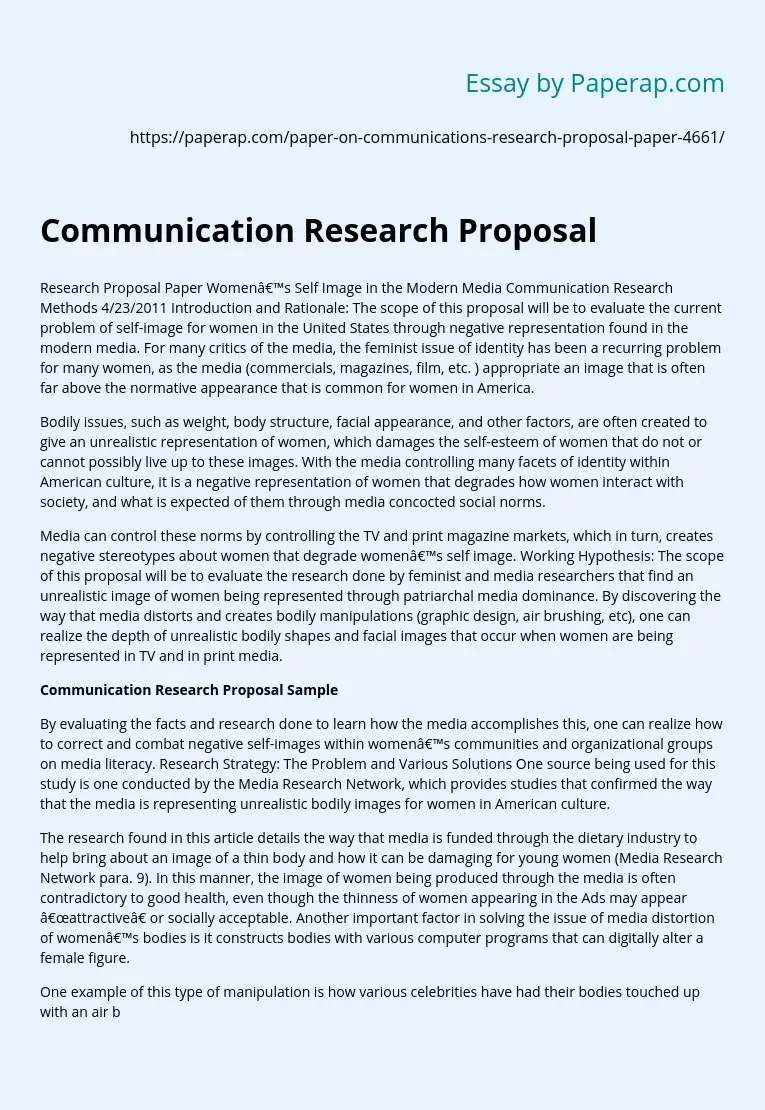Communication Research Proposal Sample
The following essay sample is a sample communication research proposal. To read the introduction, body, and conclusion of the essay, scroll down.
Research Proposal Paper Women’s Self Image in the Modern Media Communication Research Methods 4/23/2011 Introduction and Rationale: The scope of this proposal will be to evaluate the current problem of self-image for women in the United States through negative representation found in the modern media. For many critics of the media, the feminist issue of identity has been a recurring problem for many women, as the media (commercials, magazines, film, etc.
) appropriate an image that is often far above the normative appearance that is common for women in America.
Bodily issues, such as weight, body structure, facial appearance, and other factors, are often created to give an unrealistic representation of women, which damages the self-esteem of women that do not or cannot possibly live up to these images. With the media controlling many facets of identity within American culture, it is a negative representation of women that degrades how women interact with society, and what is expected of them through media concocted social norms.
Media can control these norms by controlling the TV and print magazine markets, which in turn, creates negative stereotypes about women that degrade women’s self image. Working Hypothesis: The scope of this proposal will be to evaluate the research done by feminist and media researchers that find an unrealistic image of women being represented through patriarchal media dominance. By discovering the way that media distorts and creates bodily manipulations (graphic design, air brushing, etc), one can realize the depth of unrealistic bodily shapes and facial images that occur when women are being represented in TV and in print media.
By evaluating the facts and research done to learn how the media accomplishes this, one can realize how to correct and combat negative self-images within women’s communities and organizational groups on media literacy. Research Strategy: The Problem and Various Solutions One source being used for this study is one conducted by the Media Research Network, which provides studies that confirmed the way that the media is representing unrealistic bodily images for women in American culture.
The research found in this article details the way that media is funded through the dietary industry to help bring about an image of a thin body and how it can be damaging for young women (Media Research Network para. 9). In this manner, the image of women being produced through the media is often contradictory to good health, even though the thinness of women appearing in the Ads may appear “attractive” or socially acceptable. Another important factor in solving the issue of media distortion of women’s bodies is it constructs bodies with various computer programs that can digitally alter a female figure.
One example of this type of manipulation is how various celebrities have had their bodies touched up with an air brush and digitally altered to appear without blemishes of body fat, scars or other misshapen parts of the body that do not conform with media concocted “social norms” (Derenne and Beresin para. 12). This media construct provides examples found through investigation and research that there is very few ‘natural” images of women that can be found within these types of print publications, which provide a foundation for a negative and impossibly unrealistic self image issue with women.
Due to the gravity of influence that these magazines offer women in the modern age, there is a very argument that women need to become far more media literate when seeking to understand the reality of bodily shapes and how most women look through objective point of view. By actively researching and conducting insightful analysis of how women’s images are altered, there can be preventative measures taken by women to help stave off illnesses such as bulimia and anorexia from occurring.
Certainly with media manipulating posing negative images of women that define a way for women to be socially seduced, media literacy is one major solution to helping women discover realistic ways for learning about their bodies. By teaching women through discussion groups, support groups, and other feminist orientated awareness groups to understand how the media is distorting woman’s images, there can be a lesser feeling of objectification in how women view themselves.
This form of media literacy can help women to view their bodies outside of the patriarchal construct of society that views women as sex objects only to be gazed or looked upon (Ware para. 12). This can provide a great deal of insight into preventing the exploitation of women’s bodies by corporate male executives in the media industry that wish to create women as objects of male desire. By advocating organizations and other groups to prevent this type of negative image, media literacy can be an important avenue for solving this societal problem.
Conclusion: This proposal provides the various problems with how women are exploited and negatively represented in the modern media. The research in this proposal points to the unnatural altering of women’s images to conform to a patriarchal manipulation of women into sexual objects of desire. The use of digital graphics arts to improve the image of a woman’s body into an unaltered image creates negative and unrealistic ways that women can be harmed—both mentally and physically.
These unnatural images are created through a vortex of patriarchal manipulation, which has been proven to influence bulimia and anorexia in all age levels of the female populations. Some solutions include creating media literacy organizations and groups to help inform the female public that these images are negative and wrongfully representing social norms. Also, investigations and research into media manipulation of the female body are also important factors in discerning an objective view of what is a positive or negative self-image for women in American culture.
Communication Research Proposal Sample. (2019, Dec 05). Retrieved from https://paperap.com/paper-on-communications-research-proposal-paper-4661/

